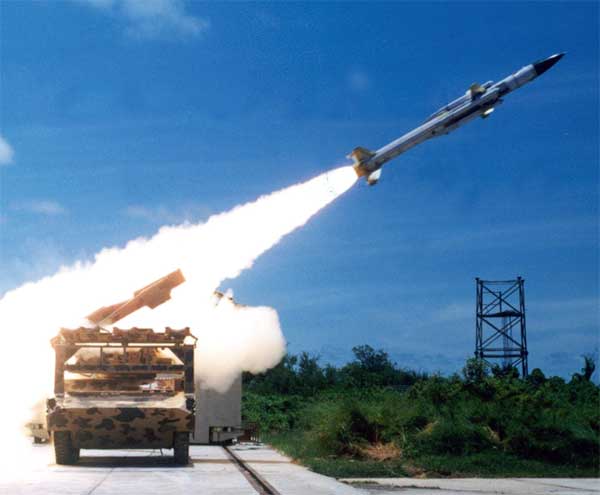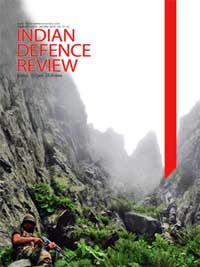Modern technology has brought about two major changes in the air defence segment of the modern battle milieu. These changes described below, have transformed the very nature of the air defence engagement warranting a change in the rules for conduct of this battle. With advancements in technology in the fields of aviation, missilery, rocketry and unmanned aerial systems the modern aerial threat has undergone a total makeover in which fighter aircraft are not the only objects to threaten the objects on ground. Unmanned constituents of this threat cannot be deterred and have to simply be destroyed, to prevent them from performing their tasks, and some of them can be engaged only by ground-based air defence weapons.
Our hostile neighbours have the capability to seriously threaten our airspace as well as assets anywhere on the ground…
The North Atlantic Treaty Organization defines air defence as, “all measures designed to nullify or reduce the effectiveness of hostile air action.” These include ground and air-based weapon systems, associated sensor systems, command and control arrangements and passive measures (e.g. barrage balloons). It may be used to protect naval, ground, and air forces in any location. However, for most countries, the main effort has tended to be ‘homeland defence’. NATO refers to airborne air defence as counter-air and naval air defence as anti-aircraft warfare. Missile defence is an extension of air defence as are initiatives to adapt air defence to the task of intercepting any projectile in flight.
In some countries such as Britain and Germany during World War II, the Soviet Union and NATO’s Allied Command Europe, ground-based air defence and air defence aircraft had been under integrated command and control. However, while overall air defence may be for homeland defence including military facilities, forces in the field, wherever they are, invariably deploy their own air defence capability, if there is an air threat. A surface-based air defence capability can also be deployed offensively to deny the use of airspace to an opponent.
Until the 1950s, guns firing ballistic munitions ranging from 20mm to 150mm were the standard weapons; guided missiles then became dominant except at the very shortest ranges (as with close-in weapon systems, which use rotary auto cannons). – Wikipedia
The Indian Neighbourhood
India is a large country with vast airspace and a number of neighbouring countries of varying shapes, sizes, ideologies and political structures. While most countries in the region view India as a large, benevolent neighbour, its relations with two countries, China and Pakistan are in a perpetual state of varying degrees of hostility.
The ground based air defence weapons inventory of the Indian army in terms of numbers, is grossly deficient to protect our ever increasing list of vulnerable national assets…
These two countries, avowed friends amongst themselves with a common adversary, have, for this part of the world, large, standing modern armed forces, equipped with modern weapons including state-of-the-art fighter aircraft, a large number of very potent missiles in various configurations along with extremely lethal arsenal of rockets and other very modern, land based or sea borne weapon systems. With their modern inventory of weapons, these ‘hostile’ neighbours have the ability to threaten the entire range Indian maritime activities, the Exclusive Economic Zones and off shore assets, the financial and strategic assets on the Western and Eastern sea boards as well as India’s assets and major population centres anywhere in the country. The military assets of these two countries, in concert or single-handedly, will play a very important role in any future battle.
The Aerial Threat
It is important to highlight the power and reach of modern aerial threat to create a disproportionate advantage for the side with a superior, state-of-the-art, full spectrum range of modern aircraft and other constituents of the aerial threat. Our hostile neighbours have the capability to seriously threaten our airspace as well as assets anywhere on the ground.
Protection of our airspace needs modernised and numerically adequate air power as well as ground based air defence weapons, which can, in a coordinated manner, counter the potent and wide spectrum aerial threat. It will be fair to mention here that while we have a fairly modern air force, the ground based air defence weapons inventory of the Indian army in terms of numbers, is grossly deficient to protect our ever increasing list of vulnerable national assets and qualitatively the present inventory, consisting of vintage weapons is simply inadequate to fight an effective air defence battle.
Users of the Airspace
There are two types of users of the air space:
Safety of our aircraft has to have a high priority in any air defence battle and air space management arrangement…
Long Term Users – The Manned Flights: So far the only long term users of the national air space have been various types of aircraft, including fighter aircraft, transport planes and helicopters. An important feature of all these users is that they are all ‘manned’ flying platforms, which can be deterred from performing their tasks.
Short Term Users: These are small projectiles, which occupy the air space intermittently, in large numbers and unless controlled and coordinated they are a potential threat to all aerial activity in the space above them. These users can be air defence artillery shells, meant to deter or destroy any aerial objects within range, air defence missiles, rockets and artillery/mortar shells on high angle trajectories which can accidentally damage aerial platforms. For the present some of the short term users can only be fired when cleared according to the weapon firing status. This arrangement will also need suitable modification.
New Long Term Users: With advancements in missile/rocket technology as well as the introduction of Unmanned Aerial Systems (UAS), now there are new long term users, in much larger numbers, much more than fighter aircraft, which will occupy the same space that was till now available only to aircraft. Presence of these new, unmanned, users, available with our neighbours adds a new dimension to the conduct of air defence battles. The following issues need a mention about these new users:
All the enemy UAS/missiles/rockets approaching or already in our air space will have to be detected, engaged and destroyed before they reach the weapon release line or line of engagement. To prevent collateral damage in own territory, due to debris, where possible, these intruding aerial systems will need to be destroyed within the enemy air space. Such engagements are possible only when ground based air defences with long range detection capability, to look into the enemy air space, and adequately long range for engagement over enemy territory, are deployed at suitable locations with adequate autonomy to neutralise the threat.
Today there are kinetic energy hit-to-kill air defence weapons with nearly absolute kill probability…
Fighter aircraft have the capability to destroy enemy aircraft as well as targets on the ground but fighter aircraft may not be the most suitable and cost effective platform for engaging and destroying this new threat. Theoretically, at least the new long term users of the air space can be in sufficiently large numbers to inundate a given segment of the air space and may not have a suitable target profile for engagement by a fighter aircraft. Also, if this new threat is not adequately detected, engaged and destroyed in time, it can cause unacceptable damage to our national assets as well as tactical assets in the battle field.
Fighter Aircraft – Symbols of National Power:
They take the battle to the enemy. As fighter aircraft occupy the air space for long durations, they are very versatile weapon platforms capable of need-based, high speed manoeuvers, moving in predictable directions, they have equipment with which they can dominate the space around them and cause large scale destruction of multiple targets on the ground. Some of the modern fighter aircraft have the capability to remain invisible even to the modern radar systems. Fighter aircraft are symbols of national power and they carry the war into the enemy territory completely annihilate the enemy’s war waging capability by destroying the enemy’s ability to fight a battle as well as provide support to ground operations.
An important aspect regarding employment of air power more offensively is to free the fighter aircraft from air defence duties to the extent possible so as to focus on long term, detailed destruction of the enemy. Safety of our aircraft has to have a high priority in any air defence battle and air space management arrangement. To prevent fratricidal conflict situations, for the present, all ground-based weapons are kept on hold for as long as the friendly aircraft are overhead or are expected to be routed over the ground based air defences. This arrangement needs an urgent review because of the following:
Historically, gun-based air defence with very low kill probability, was assigned the role of deterring the aerial threat…
• Tools offered by modern technology allow an unprecedented level of battlefield transparency and situational awareness that nearly all fratricidal conflict situations can be foreseen and prevented. We need to evolve procedures, which will not restrict the ground-based air defence weapons for more than the barest minimum time to ensure safe passage for the friendly aerial platforms.
• The technology for in-flight recognition (Identification Friend or Foe) is available for preventing any fratricidal engagements. We need to invest resources to either acquire the most modern version of this technology or develop it in the country to ensure safety of friendly aircraft.
• The potential of modern ground-based air defence weapons to detect, engage and destroy hostile aerial activity, a very high proportion of which will be unmanned, should not be constrained because of the operational requirements.
• The tactical battle area where the mechanised formations are positioned to undertake massive offensive action have a very high density of units engaged in battle or awaiting action. These units and formations, which can enter and capture the enemy territory, destroy enemy forces and obtain a decisive outcome, will be prime targets for the entire spectrum of air threat. Unless adequately protected at all times, these equipment intensive, mechanised, offensive formations are very vulnerable to enemy aerial threat. The weapons protecting these units and formations in the tactical battle area must be afforded the maximum opportunity to perform their task without any undue restrictions.
• Another aspect which needs to be recognised is that no nation can afford the number of fighter aircraft, which can protect all our national assets. All of these assets will be threatened by the new entrants to the threat spectrum, which can be countered only by the ground based air defence weapons. Some of these assets are so important that they must have round-the-clock protection. Air defence weapons protecting these assets must have adequate opportunity to engage and destroy the threat.






